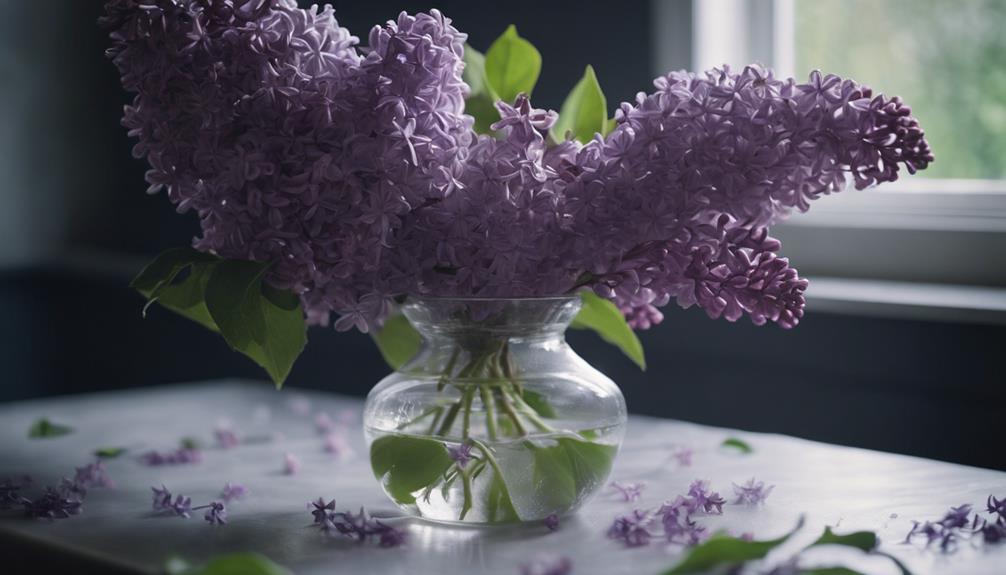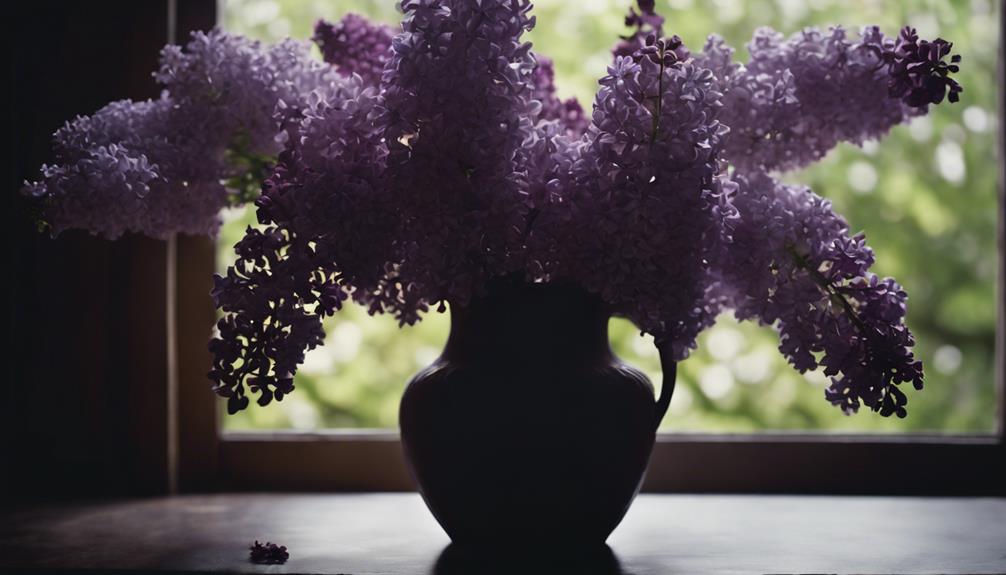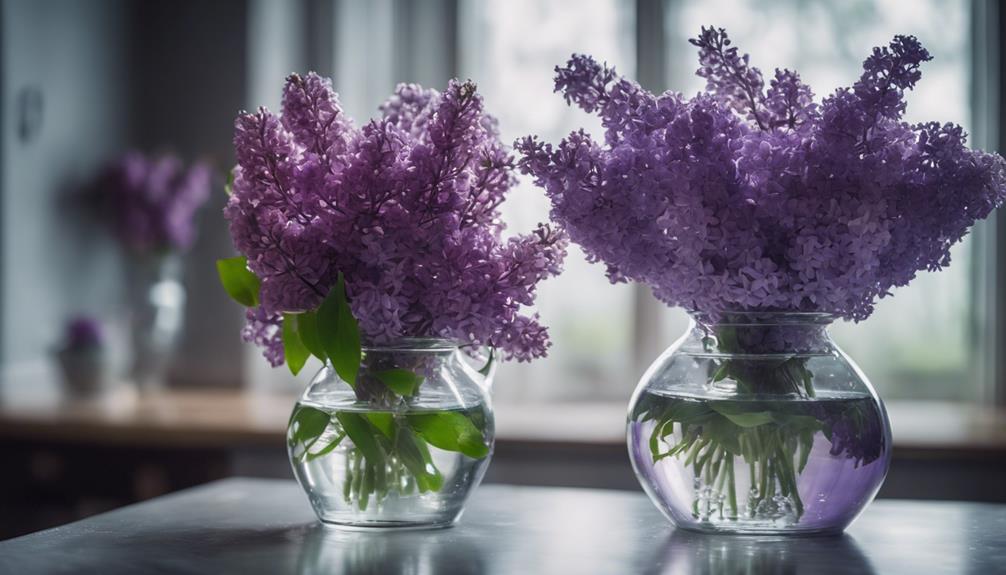For longer-lasting cut lilacs in a vase, pick ones with mostly open flowers and cut them at an angle. Hydrate stems in clean water and remove extra leaves to prevent wilting. Allow lilacs to rest in a dark, cool spot before arranging in a vase with good air circulation. Change the water every 2-3 days and keep them away from direct sunlight. Following these steps will help you enjoy your lilacs for longer!
Selecting the Best Lilacs
When selecting the best lilacs for a vase arrangement, opt for blooms with at least 3/4 of their flowers open for longer vase life.
To keep lilacs from wilting prematurely, it's important to make sure that the flowers are at the right stage of bloom.
Once you have chosen the ideal lilacs, the next step is to prepare them correctly. Start by cutting the stem ends of the lilacs at a 45-degree angle. This angled cut increases water absorption, allowing the flowers to stay hydrated and fresh for a more extended period.
Additionally, removing most of the leaves from the stems helps prevent wilting and allows the flowers to focus on water intake.
By taking these simple steps when preparing your lilacs, you can ensure that they remain vibrant and beautiful in your vase arrangement.
Keeping the stem ends clean and hydrated is key to extending the vase life of your cut lilacs.
Optimal Picking Time
For maximum vase life, make sure you pick lilacs in the morning or evening when they're most hydrated. In the morning, the flowers are filled with moisture from the night, while in the evening, they've had time to recover from the heat of the day. This ideal picking time guarantees that the lilacs have enough water content in their stems to last longer once arranged in a vase.
When selecting the lilacs, look for stems with at least three-quarters of the flowers open. This indicates that the blooms are mature and will continue to open once placed in water.
Before cutting the blooms, fill a bucket half full of fresh, cool water. This step helps to maintain the hydration of the flowers after being picked.
Proper Stem Cutting Technique

To guarantee maximum water absorption and longevity, how should you precisely trim lilac stems for a vase arrangement?
When preparing your lilacs for a vase, make sure you cut the stems at a 45-degree angle. This angle increases the surface area available for water intake, keeping your flowers fresh for a longer period. The slanted cut prevents the stem from sitting flat at the vase's bottom, allowing for better water absorption.
Making a fresh cut just before placing the stems in water is crucial to ensure top hydration.
When cutting the stems, use sharp and clean garden shears to avoid crushing the vascular system, which can hinder water uptake. Additionally, removing any excess foliage that will be submerged in water helps prevent bacterial growth, keeping your arrangement healthy.
Leaf Removal Process
To guarantee your lilacs stay vibrant, trim the leaves to enhance water absorption and prevent bacterial growth.
By removing excess foliage, you direct nutrients to the blooms, prolonging their vase life.
Remember to leave just the top 1-2 leaves for a polished look in your arrangement.
Trim Leaves for Longevity
Consider carefully removing the majority of leaves from lilac stems, retaining only the top 1-2 leaves closest to the blooms to promote longevity in a vase. By trimming the leaves effectively, you can help your lilacs stay fresh for a longer period.
Here's why you should trim the leaves:
- Prevent Wilting: Removing excess leaves reduces water loss, preventing premature wilting of the blooms.
- Avoid Bacteria Growth: Less foliage in the water inhibits bacterial growth, keeping your lilacs healthier for an extended time.
- Enhance Aesthetic Appeal: Trimming the leaves not only benefits the lilacs' longevity but also improves the overall appearance of your floral arrangement.
Enhance Water Absorption
Improving water absorption in lilac stems by eliminating excess leaves is vital for preserving their freshness in a vase. When you remove most of the leaves from the stems, you help prevent water loss and maintain the blooms' freshness for a longer period.
Leaves left on the stems can lead to bacterial growth in the water, shortening the vase life of the lilacs. By focusing on hydrating the flowers through leaf removal, you allow the stems to absorb water more efficiently, ultimately prolonging the vibrancy of the blooms in the vase.
This process guarantees that the lilacs stay looking fresh and vibrant for an extended time. Remember, proper preparation, such as removing leaves, is essential for maximizing the vase life of cut lilacs. So, take the time to eliminate excess foliage to enhance water absorption and extend the beauty of your lilac bouquet.
Prevent Bacterial Growth
Improving the longevity of lilacs in a vase involves an essential step: removing excess leaves to prevent bacterial growth.
When you arrange your cut flowers, make sure to follow these steps to guarantee your lilacs stay fresh for longer:
- Remove leaves: By taking off excess leaves from the stems, you help prevent bacterial growth in the vase, which can clog the stems and reduce water uptake, leading to wilting.
- Change water: Using fresh water and adding a floral preservative can help maintain the freshness of your lilacs for an extended period.
- Proper arrangement: Ensuring a clean and clear water environment by following the leaf removal process can prolong the beauty of your lilacs in the vase.
Dark Room Rest Period

Before moving on to the next points, consider the importance of allowing your cut lilacs to rest in a dark room for a few hours. This step aids in their hydration and revitalization, ensuring they stay fresh in the vase.
Optimal Light Exposure
To optimize the vase life of your cut lilacs, consider allowing them to rest in a dark room for a couple of hours before arranging. This dark room rest period is vital as it helps the lilacs rehydrate and last longer by minimizing their exposure to light. Here's why this step is essential:
- Preservation of Freshness: Placing lilacs in a dark room prevents wilting and premature aging, ensuring they stay fresh for a more extended period.
- Enhanced Water Absorption: The rest period allows the lilacs to absorb water and essential nutrients effectively, promoting their overall health and longevity.
- Color and Bloom Maintenance: Keeping the lilacs away from direct sunlight during the initial rest period helps maintain their vibrant colors and delicate blooms, enhancing their visual appeal in the vase.
Temperature Control Tips
Make sure to maintain a cool and stable temperature in the dark room where your cut lilacs are resting to optimize their rehydration process and extend their vase life.
During this rest period, the lilacs need a dark and cool environment to absorb water effectively and recover from being cut.
Placing them in a dark room allows the blooms to rejuvenate without the stress of direct sunlight, which can lead to premature drying.
The rest period is essential for the lilacs to rehydrate and maintain their freshness, ultimately leading to a longer lifespan in the vase.
Water Change Routine
Maintaining a regular water change routine during the dark room rest period is crucial for preserving the freshness and longevity of cut lilacs in a vase.
To guarantee your lilacs stay vibrant and beautiful, follow these key steps:
- Change the water every 2-3 days: Regular water changes help keep the environment clean and free from bacteria, extending the life of your lilacs.
- Allow the lilacs to rest in a dark place: Giving the flowers a few hours in a dark room before arranging them allows them to hydrate effectively, enhancing their lifespan.
- Use cool water and place the vase in a cool, dark area: Cool water helps maintain the freshness of the lilacs, and keeping the vase in a dark place during water changes further supports their longevity.
Choosing the Right Vase
Consider selecting a vase with a heavy bottom when preparing to display lilacs for an extended period. The weight of the lilac blooms can cause a lighter vase to tip over, potentially damaging the delicate flowers.
Additionally, opt for a vase with a wide opening to provide ample space for arranging the lilac stems. A wider opening allows for better air circulation around the blooms, helping them stay fresher for longer.
To further support the stems, you can place a chickenwire pillow inside the vase, offering stability and structure to the arrangement.
Ensuring the vase is clean and residue-free is essential to prevent bacterial growth, which can shorten the lifespan of your lilacs.
Water Quality and Change Frequency

Using clean, fresh water and changing it every two to three days is essential to prolong the life of cut lilacs in a vase.
Dirty water can lead to bacterial growth, which shortens the lifespan of the blooms.
To keep your lilacs looking vibrant and fresh, maintain the water quality by following these steps:
- Use clean, fresh water: Fill the vase with room temperature water to provide the best environment for your lilacs to thrive.
- Change the water every two to three days: Regularly replacing the water prevents bacterial buildup, ensuring the blooms stay healthy and vibrant.
- Monitor water quality: Check the water for cloudiness, discoloration, or unpleasant odors as signs that it's time for a change.
Sunlight Avoidance Tips
For optimal vase life, make sure your cut lilacs are kept away from direct sunlight to prevent premature wilting. Sunlight can quickly dry out the delicate lilac blooms, causing them to lose their freshness and vibrancy.
To guarantee your lilacs last longer in a vase, it's essential to keep them in a shaded area where they're protected from direct sunlight. Placing the vase in a cool, dark spot will help maintain the quality of your cut lilacs and prolong their vase life.
Direct sunlight poses a significant threat to the longevity of your lilac arrangement, as it can accelerate the wilting process of the flowers. By avoiding exposure to sunlight and opting for a shaded location instead, you can enjoy your beautiful lilacs for an extended period.
Conclusion
Now that you know how to make cut lilacs last longer in a vase, you can enjoy their beauty for days to come. Remember to follow these steps for the best results:
pick the freshest lilacs,
cut their stems at an angle,
remove excess leaves,
give them a dark room rest,
choose the right vase,
change the water regularly,
and keep them out of direct sunlight.
With these tips, your lilacs will stay blooming like it's nobody's business!